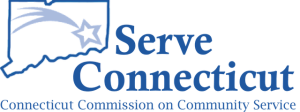Establishing Program Environment
Establishing a positive, professional program environment is a critical investment in the quality of your program’s relationship with its members, its recipients, and its stakeholders. Fostering a program environment that results in a gratifying service experience for your members will be reflected in how they serve program participants and will resonate in the brand or image your program presents to your community, your funders, and the AmeriCorps service network at large.
In creating this positive environment, give consideration to the physical location(s) in which your members will be conducting their service. The Program Director’s office should be professional, confidential and a safe place for individuals to communicate openly; it, as well as any common space utilized by members, should proudly reflect the AmeriCorps brand. Training spaces and all meetings should also be a safe place for attendees and it is imperative that the environment be unattached to religious, political and other conflicting practices.
Consider also the strong role that timely and respectful communication plays in building relationships. Email and phone inquiries from all relevant parties, including the Commission, should be treated in a professional manner.
Please be mindful that there may be situations when the Commission needs to contact staff for information that requires a timely response. Therefore, when the Program Director is out of the office to attend a conference or away for a number of days, it is important to establish an out-off-office (auto reply) e-mail and voice mail message. The message should reflect contact information of the staff covering your program duties and a time when you will return to the office.
Work Plan
Your members should know your program’s vision, mission statement, and elevator speech. Each is an element of your program’s work plan. The elevator speech is a brief description of the who, what, where, when and how of your program. Additionally, the work plan should include a statement of quantitative and qualitative reasons why this program is essential for the community. Researching, organizing, and evaluating service/host site locations as well as creating strong program objectives are all part of your program’s work plan. The work plan would also include a well thought out annual calendar which includes CCCS deadlines, trainings, and events for the 12-month grant period. All programs should have an established plan for how the calendar is maintained, updated and distributed.
The work plan should also include staff roles and development goals. The work plan is a strategy for ensuring that your program has adequate, trained and passionate staff members.
AmeriCorps Longevity
As economic trends differ yearly, each grant funding cycle becomes more competitive. Being able to demonstrate a strong plan for sustainability reassures funders of their investment.
The more support from members, volunteers, funding sources, staff, board members and the community that your program receives, the more achievable your program’s sustainability becomes. Both a community needs assessment and organizational chart are useful aids that can be used to create support and program buy-in. A community needs assessment is a functional tool that will allow you, your organization, and critical board members to realize the impact that your AmeriCorps program can have on your community. An organizational chart can be helpful in demonstrating the program design.
The Corporation resources will help you develop a program that is sustainable, builds organizational and local capacity, engages community volunteers, and produces outcomes beyond those accomplished by AmeriCorps members alone. It will offer a variety of methods, approaches and strategies that can be implemented for your program’s sustainability and capacity building plans.
Please view the Program Management Resources for templates on these tools.
